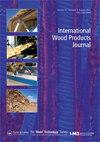Improved adhesive-bond performance in copper azole and disodium octaborate tetrahydrate-treated Eucalyptus grandis laminates
IF 0.9
Q2 MATERIALS SCIENCE, PAPER & WOOD
引用次数: 1
Abstract
ABSTRACT The prospect of manufacturing durable structural laminated wood with copper and boron-based preservative-impregnated Eucalyptus grandis wood was previously investigated but revealed adhesive-bond performance below standard requirements. In this study, bonding process factors, viz. mechanical pretreatment (surface planing) and bonding pressure in conjunction with wood preservative and adhesive compatibility for improved bond performance in preservative-treated E. grandis laminates were investigated. The results obtained showed significant and satisfactory improvement in shear strength and delamination resistance of E. grandis laminates based on EN 14080:2013 [Timber structures — Glued laminated timber and glued solid timber — Requirements, BSI Stand. Publ. (2014) 1–110] requirements. The suitability of polyurethane, melamine-urea-formaldehyde, and phenol-resorcinol-formaldehyde adhesives for bonding copper azole (CA) and disodium octaborate tetrahydrate (DOT)-impregnated E. grandis wood was established. Satisfactory pathways, including greener process routes for manufacturing CA and DOT-impregnated E. grandis laminates for structural applications in tropical and subtropical climes were achieved. The established processes could be readily adopted industrially to enhance the global implementation of solid wood composites and promote hardwood bonding.唑铜和四水合八酸二钠处理的桉树层压板粘接性能的改善
以前研究过用铜和硼基防腐剂浸渍的桉树木材制造耐用结构层压木材的前景,但发现胶合性能低于标准要求。在本研究中,研究了粘合过程因素,即机械预处理(表面刨平)和粘合压力,以及木材防腐剂和粘合剂的相容性,以改善防腐处理的大叶青层压板的粘合性能。结果表明,根据EN 14080:2013[木结构-胶合层压木材和胶合实木-要求,BSI Stand], E. grandis层压板在抗剪强度和抗分层性方面有了显著而令人满意的改善。出版。(2014) 1-110]要求。研究了聚氨酯、三聚氰胺-脲醛和苯酚-间苯二酚-甲醛三种胶粘剂对唑铜(CA)和四水合辛硼酸二钠(DOT)浸渍木的粘接性能。令人满意的途径,包括制造用于热带和亚热带气候的结构应用的CA和dot浸渍E. grandis层压板的绿色工艺路线。建立的工艺可以很容易地在工业上采用,以加强全球实木复合材料的实施,促进硬木粘合。
本文章由计算机程序翻译,如有差异,请以英文原文为准。
求助全文
约1分钟内获得全文
求助全文
来源期刊

International Wood Products Journal
MATERIALS SCIENCE, PAPER & WOOD-
CiteScore
2.40
自引率
0.00%
发文量
27
 求助内容:
求助内容: 应助结果提醒方式:
应助结果提醒方式:


